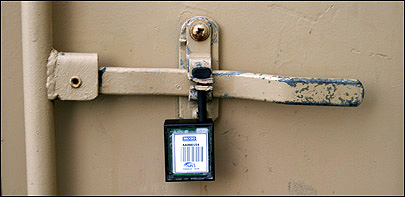I was invited by the MIT Enterprise Forum of Cambridge to do a presentation and host a panel on electronic seals—active radio frequency identification devices that can detect unauthorized entry into a container. Since the terrorist attacks on New York City and Washington, D.C., on Sept. 11, 2001, there have been great concerns about a terrorist sneaking a weapon of mass destruction into a country by hiding it in a container. Despite that fear, little progress has been made toward preventing this from happening. While RFID has some potential to secure cargo containers, the panel discussion made it clear that adopting e-seals is not going to happen quickly, and e-seals are not a panacea.
Originally, e-seals were designed to prevent someone from taking something out of the container (stealing). But e-seals are now being seen as a way to prevent someone from putting something into the container (such as a nuclear weapon). After the container is closed, a bolt or cable attached to a box with an active RFID transponder is put through the holes normally used for a lock. If the seal is tampered with, that information is communicated to an interrogator the next time the tag is read. The main benefit of e-seals is that they can be read automatically, rather than requiring staff to check each seal to see if it’s been tampered with.
|
|
A technical committee of the International Organization for Standardization (ISO) has been working to create an international standard for e-seals, ISO 18185. There has been some disagreement among vendors represented on the technical committee about the standard. Savi Technology has been a prime mover in pushing for a standard that will allow for the introduction of a low-cost, base-level e-seal to spur market adoption. But Motorola doesn’t think the proposed standard includes enough data security. And GE Global Research feels that an external device is too easily tampered with or spoofed. It’s chosen to produce and market a container security device that does not use RFID; it goes on the inside of the container to prevent someone from tampering with the device itself.
My panel included representatives from these three companies: Walter Dixon, project leader for port and cargo security at GE Global Research; Juergen Reinold, senior director of Motorola’s Secure Assets Division; and Fraser Jennings, VP of standards and regulatory activities at Savi Technology. Also on the panel, representing the end-user community, was Nick Tsougas, a senior logistics analyst with the U.S. Department of Defense.
Standards are critical to achieving adoption of e-seals. It would not be feasible for shippers to put different seals on different containers depending on which port a container was going to, or which border it would cross on a truck. The vendors on the panel said they expect a standard to be approved by the end of next year, though some end users are skeptical. They point out that a vendor whose market position would be hurt by a standard could slow adoption by raising continual objections on technical grounds.
The panelists also raised other barriers to adoption of e-seals, beyond the challenges of getting a global standard. One is the cost of the infrastructure. Who will pay for interrogators to be deployed at ports around the globe? Hutchison Port Holdings has teamed with Savi to deploy the infrastructure at Hutchison ports. The partners plan to sell the solution as a service to other terminal operators (see Savi, HPH Form Joint Venture). However, other ports are reluctant to invest in the technology because they don’t see a return on investment.
Another issue is that e-seals alone don’t solve the security problem. What, for instance, if someone were to cut a hole in the top or side of a container? Some vendors are looking at sensors that could detect light and communicate its presence to an e-seal on the outside of the container, which could communicate that to an interrogator.
But terrorists aren’t dumb. They will quickly learn about these sensors and figure out ways to get around them. “Someone can get hired at a company and sneak something into the container when it’s being loaded,” said Reinold. “Then it’s sealed and the seal is never broken.”
RFID tagging the items that go into the container helps create a cargo manifest that can indicate to customs officials that the shipment is legitimate, but there is currently no way to detect the presence of a package that isn’t tagged. “It only takes a small amount of plutonium to make a nuclear bomb,” said Dixon, “so trying to detect that based on the volume of items in a container is not realistic.”
The general feeling among the panelists was that e-seals offer some limited protection and are a good starting point. They said that a new generation of smarter containers with built-in security features is probably needed, and that adoption will take time and probably be driven by the economic benefits that come with tracking cargo. The problem I see is that no one is really motivated to solve these problems. Companies are not eager to invest in new, more secure containers or e-seals because it adds an additional expense.
Meanwhile, the supply chain remains vulnerable. My fear is that there will be a terrorist attack. Even if terrorists use conventional explosives and not a nuclear weapon or “dirty bomb,” which spreads nuclear waste with conventional explosives, politicians will react by introducing mandatory solutions, which may or may not be helpful but will certainly be a burden on shippers, carriers and ports.
What we need is for the ISO standard to be approved as swiftly as possible, and for shippers to launch trials even before then. If the seals provide visibility into the location of cargo, in addition to providing a small level of security, that will foster adoption, and as imperfect as e-seals are, they are better than nothing. Governments around the world would also be smart to invest in research and development of low-cost light, temperature and radiation sensors that might be combined with e-seals to boost security. And we need better batteries to power these devices over longer periods.
A small amount invested today could avert a disaster tomorrow.
Mark Roberti is the founder and editor of RFID Journal. If you would like to comment on this article, click on the link below.



